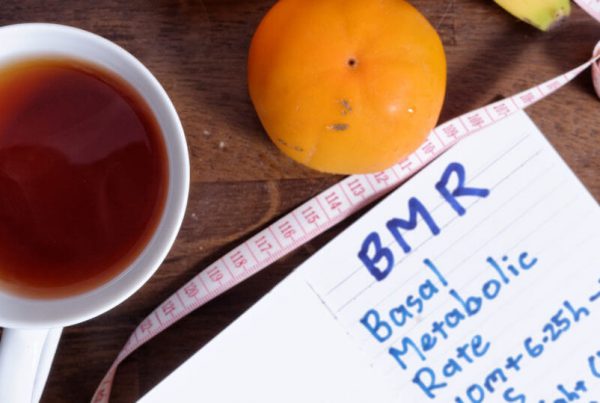Editor’s Note: This post was updated on August 14, 2018, for accuracy and comprehensiveness. It was originally published on June 16, 2015.
- Detailed body composition analysis uses the 4C Model that breaks the body into body water, protein, minerals, fat.
- Fat and muscle may weigh the same, but muscle is significantly denser than body fat.
- The four common methods of measuring your body composition are calipers, hydrostatic weighing, DEXA, and BIA.
At your recent physical, your doctor mentions that you should get body composition tested. You’ve overheard trainers tell their clients how much their body composition has improved. You keep seeing the term pop up on fitness or health blogs (like yours truly). You may smile and nod knowingly when it comes up in conversation, but secretly, deep down, you’ve always been thinking:
“What exactly is body composition?”
If this sounds like you, fear not, you’re in the right place.
Body composition analysis is a trending topic in health, medicine, and fitness because it is a whole body assessment that gives you the blueprint for improving your health.

Think about when you take your car into the shop for an inspection. In order to examine the condition of the car, the mechanic opens the hood, checks the fluids, and inspects the working components.
Body composition analysis is the same idea, except instead of examining your engine oil level or testing the battery life, you are getting a measurement of your fat, muscle mass, and body water levels.
By “looking under the hood” and understanding what areas you need to improve on in order to achieve a healthy body composition, you will look and feel so much better!
This Is What You Are Made Of

Let’s start with the basics. The first thing to know is that there are several different models of body composition. Below we will explore the two most common models.
2C Model
1. Fat Mass
The substance everyone seems to always have too much of and is always doing their best to get rid of. However, body fat is necessary for the body to function: Body Fat allows the body to store energy, protects internal organs, acts as an insulator and regulates body temperature, among other things. Nobody can have 0% body fat, and maintaining body fat percentages lower than 4% is generally regarded as inadvisable for long-term health.
2. Fat-Free Mass (FFM)
Fat-Free Mass is what it sounds like – all the mass in your body that is not attributed to fat. Your FFM contains a variety of different components, all your internal organs, skeletal muscle mass, water, etc. Everything that is not fat can be lumped into the category of Fat-Free Mass.
From these two values, your body fat percentage can be deduced by dividing your fat mass by your total body weight. If your goal is to determine only your body fat (not lean body mass, muscle mass, etc), procedures that utilize the 2C method can be used to determine your body composition.
4C Model
For a more detailed body composition analysis, you have to use methods that break the body into more components, such as the 4 component (4C) model.
 This breaks your body into the following four components:
This breaks your body into the following four components:
1. Body Water
Adults are more than 50% water. Your body fat, muscles, blood, and other bodily fluids all contain water. These components can be further broken down into the water contained inside your body’s cells (intracellular water) and the water outside your cells (extracellular water).
2. Protein
This is a reflection of the protein contained in your body’s muscles.
3. Minerals
Your body contains minerals which are primarily contained in two places: in the bloodstream and inside the bone tissue.
4. Fat
Here are some less common (but important) body composition terms:
- Dry Lean Mass (DLM): Your Dry Lean Mass is the combination of the weight attributed to the protein and the bone mineral in your body.
- Lean Body Mass (LBM): Your Lean Body Mass is the combination of your DLM and body water.
- Skeletal Muscle Mass (SMM): Not to be confused with DLM or LBM, Skeletal Muscle Mass are the muscles that are connected to your bones and allow you to move. These are all the muscles that can be grown and developed through exercise (your pectorals, biceps, quadriceps, and so on).
These terms together give you a more sophisticated way to think about and approach both your body weight and your health. Put simply, you’ve got to know your body composition if you are serious about reaching your health goals and improving your quality of life. Without knowing what you’re actually made of, you can only guess at how much muscle and body fat you actually have. Guessing leads to frustration, frustration leads to indifference, and indifference leads to quitting.
What’s So Important About Body Composition, Anyway?

At this point, you might be a little overwhelmed with these new terms, and think, “Thanks, but no thanks. I will just stick with something traditional and easy like Body Mass Index.”
But the Centers of Disease Control and Prevention (CDC) has found that while BMI can be used to categorize people into weight categories that have a higher chance of developing health complications, it is not an accurate tool to measure body fatness or assess health because it does not differentiate what your body weight is made up of.
The reason why that is important is that although fat and muscle may weigh the same, muscle is significantly denser than body fat. That means that 15 pounds of muscle takes up much less space than 15 pounds of fat.

So what does this mean for the average person who is looking to stay healthy? Well, if you’re simply just that: average (neither athletic nor overweight), then BMI can be a fairly good indicator to measure if you are at a healthy weight. But if you are even a little bit athletic, or if you lead a fairly sedentary lifestyle, BMI can be misleading.
Take a star NFL tight end. At 6’6”, 262 pounds he would have a BMI of 28.8 – and according to the World Health Organization, an individual with a BMI score of 30 is classified as “obese.” But you wouldn’t consider him almost obese when you see him sprint away from NFL defensive backs.

And when we look at this muscle and body fat levels, his body composition results agree.
The muscle mass and percentage muscle mass measurements show an individual with high Skeletal Muscle Mass and low Percent Body Fat (12.7%).
The reason his body weight is so high is that more than half of his body weight is made up of muscle. Although BMI may not be an accurate measurement tool for rich professional athletes, you might be wondering what does this have to do with me.
Well if you are like 150 million American office workers who aren’t getting enough exercise, BMI may be giving you a false sense of security.
For example, picture your average office worker as 5’4” and 140 pounds for a BMI score of 23.1: solidly in the “normal” BMI range. This person may want to improve their fitness level, but it’s not a high priority because her BMI is still pretty good.
Sedentary adults working in offices who do not exercise are known to lose Skeletal Muscle mass, especially in their legs. Coupled with a similar increase in body fat This can lead to high body fat percentages, even in individuals with “normal” body weight and BMI. This condition is called skinny fat, and because of our reliance on body weight measurement and BMI, it often goes undetected.

The muscle mass and percentage muscle mass measurements show an individual with low Skeletal Muscle Mass and High Percent Body Fat (31.1%).
These individuals are at risk for some of the same health complications as people who are visibly overweight, with BMI values above 25. These health complications can include cardiovascular disease, high blood pressure, diabetes, and more.
It then makes sense that in a Canadian study of 50,000 people, it was found that a low BMI did not necessarily correspond with a lower mortality rate.
How Can You Check Your Body Composition?
Hopefully, by now we have convinced you the importance of using something more advanced than a weight scale or BMI. Luckily, there are many methods to determine your body composition. Some are quick and easy but provide basic information only. Some are lengthy and expensive and require the assistance of a trained technician to administer a test.
Here are four common methods:
Skinfold Calipers

Image Credit: Flickr
This is a method that many people have encountered in their local gym. Calipers are widely used because they are portable, easy to use, and can be administered by almost anyone as long as they have had proper training and sufficient experience.
Calipers work by pinching external body fat in several places around your body and measuring how much skinfold can be grasped by the caliper’s arms. These results are taken and used in mathematical calculations, which determine the fat mass in your entire body.
If this sounds simple, that’s because it is. Calipers are an example of 2C body composition analysis. Calipers will tell you how much fat you have, but that’s about it.
The other thing to be aware of when you are using calipers to test your body composition is that the accuracy of your results may vary across tests, and the reproducibility (having consistent test results when back-to-back testing) won’t be as high as tests performed on medical-grade machines, which are designed to reduce variance across tests and increase accuracy.
Hydrostatic Weighing

Image Credit: Chemistry Land
Hydrostatic weighing (also known as underwater weighing) calculates your body fat percentage using you underwater body weight. To get your underwater weight, you first need to expel all of the air in your lungs and then submerge yourself in a pool while sitting on a special scale. Your underwater weight is compared with what you weigh on land, and these numbers, together with the value of the density of the water in the pool, are put through a series of calculations. These calculations produce your body fat percentage.
When done properly, hydrostatic weighing is a very precise method for measuring your body fat percentage, and it is often regarded as “Gold Standard” for body composition analysis. However, just like calipers, hydrostatic weighing cannot report anything beyond body fat, like skeletal muscle mass, body water, and dry lean mass.
To get a hydrostatic weighing test performed, you will need to make an appointment at a facility such as a university or high-end sports complex that has built a hydrostatic weighing pool and a trained staff.
Dual Energy X-Ray Absorptiometry (DEXA)

Image Credit: Nick Smith photography
DEXA (sometimes abbreviated as DXA), is a medical test that involves lying on a table while a machine sends X-rays through your body and measures the difference in the amount of energy initially sent through the body and the amount detected after it exits the body. Although DEXA was originally designed to measure bone density, it is now used to measure body fat and muscle mass.
Along with hydrostatic weighing, DEXA scans are regarded as a “Gold Standard” for measuring body fat percentage. Unlike calipers and underwater weighing, DEXA scans have the ability to measure the body segmentally, scanning each arm and the trunk separately in order to accurately measure fat mass, soft lean mass, and bone density in each segment.
In order to get a DEXA scan performed, you will typically need to make an appointment with a hospital or clinic that has a DEXA device. You may need to do some research; because of the cost, not all hospitals and clinics will have a DEXA machine.
Bioelectric Impedance Analysis (BIA)

Bioelectrical Impedance Analysis (BIA) works by sending a small electrical current into a person and measuring the opposition of that current (impedance) as it travels throughout the body’s water. Once impedance is measured, body composition is calculated. Unlike other methods, a technician does not always need to be present at a BIA test, and you can use BIA devices with just by following the directions on the device.
BIA devices range widely in quality and accuracy, and you should be aware that not all BIA devices test the entire body. Consumer body composition scales, use BIA to directly measure leg impedance only and use estimations to determine results for the upper body. Handheld devices only directly measure arm impedance and estimate results for the lower body.
By contrast, modern, medical-grade BIA devices are able to measure the entire body directly and can be extremely accurate – with measurements that are closely aligned with “Gold Standard” procedures – without the complications that those procedures sometimes entail. The most advanced BIA devices are even able to perform segmental analysis.
Because BIA measures work by measuring body water, a lot of useful information can be reported. Although nearly all BIA devices will tell you your body fat percentage, some devices can go much further and report the body water weight, skeletal muscle mass, lean body mass, and much more.
Hopefully, this helps you a general understanding of body composition. Knowing your body composition is the first step towards improving it, so if you’re able, schedule a body composition test soon. Your body composition test results can aid you immensely in understanding your weight, improving your overall health, and helping you achieve your fitness goals.
For a recap, check out this video:





